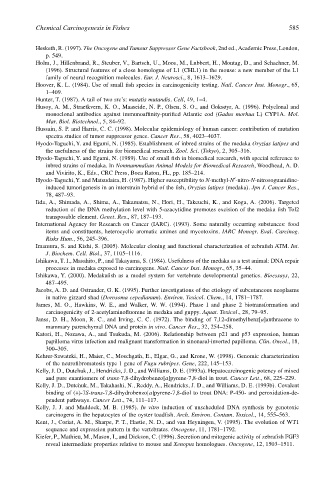Page 605 - The Toxicology of Fishes
P. 605
Chemical Carcinogenesis in Fishes 585
Hesketh, R. (1997). The Oncogene and Tumour Suppressor Gene Factsbook, 2nd ed., Academic Press, London,
p. 549.
Holm, J., Hillenbrand, R., Steuber, V., Bartsch, U., Moos, M., Lubbert, H., Montag, D., and Schachner, M.
(1996). Structural features of a close homologue of L1 (CHL1) in the mouse: a new member of the L1
family of neural recognition molecules. Eur. J. Neurosci., 8, 1613–1629.
Hoover, K. L. (1984). Use of small fish species in carcinogenicity testing. Natl. Cancer Inst. Monogr., 65,
1–409.
Hunter, T. (1987). A tail of two src’s: mutatis mutandis. Cell, 49, 1–4.
Husoy, A. M., Straetkvern, K. O., Maaseide, N. P., Olsen, S. O., and Goksøyr, A. (1996). Polyclonal and
monoclonal antibodies against immunoaffinity-purified Atlantic cod (Gadus morhua L) CYP1A. Mol.
Mar. Biol. Biotechnol., 5, 84–92.
Hussain, S. P. and Harris, C. C. (1998). Molecular epidemiology of human cancer: contribution of mutation
spectra studies of tumor suppressor genes. Cancer Res., 58, 4023–4037.
Hyodo-Taguchi, Y. and Egami, N. (1985). Establishment of inbred strains of the medaka Oryzias latipes and
the usefulness of the strains for biomedical research. Zool. Sci. (Tokyo), 2, 305–316.
Hyodo-Taguchi, Y. and Egami, N. (1989). Use of small fish in biomedical research, with special reference to
inbred strains of medaka. In Nonmammalian Animal Models for Biomedical Research, Woodhead, A. D.
and Vivirito, K., Eds., CRC Press, Boca Raton, FL, pp. 185–214.
Hyodo-Taguchi, Y. and Matsudaira, H. (1987). Higher susceptibility to N-methyl-N′-nitro-N-nitrosoguanidine-
induced tumorigenesis in an interstrain hybrid of the fish, Oryzias latipes (medaka). Jpn J. Cancer Res.,
78, 487–93.
Iida, A., Shimada, A., Shima, A., Takamatsu, N., Hori, H., Takeuchi, K., and Koga, A. (2006). Targeted
reduction of the DNA methylation level with 5-azacytidine promotes excision of the medaka fish Tol2
transposable element. Genet. Res., 87, 187–193.
International Agency for Research on Cancer (IARC). (1993). Some naturally occurring substances: food
items and constituents, heterocyclic aromatic amines and mycotoxins. IARC Monogr. Eval. Carcinog.
Risks Hum., 56, 245–396.
Imamura, S. and Kishi, S. (2005). Molecular cloning and functional characterization of zebrafish ATM. Int.
J. Biochem. Cell. Biol., 37, 1105–1116.
Ishikawa, T. I., Masahito, P., and Takayama, S. (1984). Usefulness of the medaka as a test animal: DNA repair
processes in medaka exposed to carcinogens. Natl. Cancer Inst. Monogr., 65, 35–44.
Ishikawa, Y. (2000). Medakafish as a model system for vertebrate developmental genetics. Bioessays, 22,
487–495.
Jacobs, A. D. and Ostrander, G. K. (1995). Further investigations of the etiology of subcutaneous neoplasms
in native gizzard shad (Dorosoma cepedianum). Environ. Toxicol. Chem., 14, 1781–1787.
James, M. O., Hawkins, W. E., and Walker, W. W. (1994). Phase I and phase 2 biotransformation and
carcinogenicity of 2-acetylaminofluorene in medaka and guppy. Aquat. Toxicol., 28, 79–95.
Janss, D. H., Moon, R. C., and Irving, C. C. (1972). The binding of 7,12-dimethylbenz[a]anthracene to
mammary parenchymal DNA and protein in vivo. Cancer Res., 32, 254–258.
Katori, H., Nozawa, A., and Tsukuda, M. (2006). Relationship between p21 and p53 expression, human
papilloma virus infection and malignant transformation in sinonasal-inverted papilloma. Clin. Oncol., 18,
300–305.
Kehrer-Sawatzki, H., Maier, C., Moschgath, E., Elgar, G., and Krone, W. (1998). Genomic characterization
of the neurofibromatosis type 1 gene of Fugu rubripes. Gene, 222, 145–153.
Kelly, J. D., Dutchuk, J., Hendricks, J. D., and Williams, D. E. (1993a). Hepatocarcinogenic potency of mixed
and pure enantiomers of trans-7,8-dihydrobenzo[a]pyrene-7,8-diol in trout. Cancer Lett., 68, 225–229.
Kelly, J. D., Dutchuk, M., Takahashi, N., Reddy, A., Hendricks, J. D., and Williams, D. E. (1993b). Covalent
binding of (+)-7S-trans-7,8-dihydrobenzo[a]pyrene-7,8-diol to trout DNA: P-450- and peroxidation-de-
pendent pathways. Cancer Lett., 74, 111–117.
Kelly, J. J. and Maddock, M. B. (1985). In vitro induction of unscheduled DNA synthesis by genotoxic
carcinogens in the hepatocytes of the oyster toadfish. Arch. Environ. Contam. Toxicol., 14, 555–563.
Kent, J., Coriat, A. M., Sharpe, P. T., Hastie, N. D., and van Heyningen, V. (1995). The evolution of WT1
sequence and expression pattern in the vertebrates. Oncogene, 11, 1781–1792.
Kiefer, P., Mathieu, M., Mason, I., and Dickson, C. (1996). Secretion and mitogenic activity of zebrafish FGF3
reveal intermediate properties relative to mouse and Xenopus homologues. Oncogene, 12, 1503–1511.

